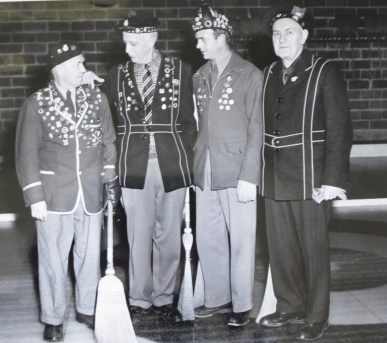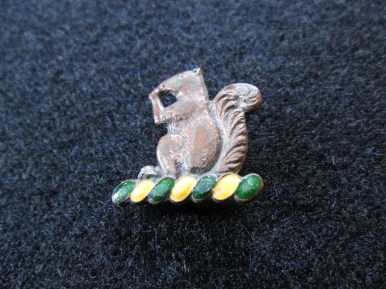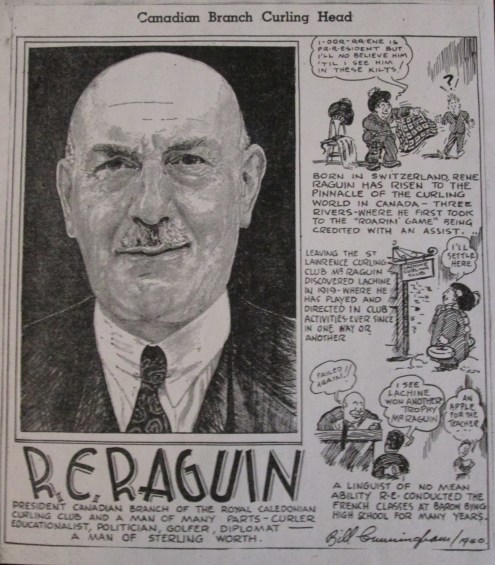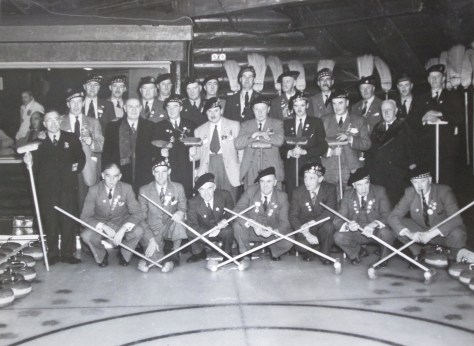My Swiss grandfather became enthralled with curling when he came to Canada. Curling is a game invented by the Scots but my Scottish ancestors never took up the sport.
René Raguin came to Canada from Switzerland in 1910 to teach school. He knew all about winter and cold weather sports. He had skied, sledded and climbed in his homeland. Once, he cut his leg on a bobsled runner and didn’t realize the extent of the injury until until he was at the bottom of the hill. All of his trips down hill weren’t on sleds with sharp runners, some for fun were on metal trays. I am sure he thought throwing “irons” on ice would be easy when he first tried curling in Trois Rivière.

Curling is a game played on a sheet of ice where rocks are thrown from the hack to the rings at the other end and one tries to get closer to the centre or button than one’s opponents. Lakes and ponds hosted the first games, played with granite stones which were plentiful in Scotland. The stones are now carved and polished so they glide over the ice and a twist of the handle gives the curl.
The Grand Caledonian Curling Club was formed in 1838 to regulate this ancient Scottish game. Apparently many rules were needed for throwing rocks on ice. The club later received its royal charter from Queen Victoria and became the Royal Caledonian Curling Club (RCCC), the mother club of the sport.
It is generally accepted that the 78th Fraser Highland Regiment brought curling to Canada in the mid 1700s. The soldiers melted cannonballs to make iron curling “stones” and curled in Québec City. Curling then moved to Montreal where men first played on cleared patches of ice on the St Lawrence river before it moved indoors. Quebecers continued to curl with “irons” until the early 1950s while the rest of the country played with granite.
When René moved to Montreal he didn’t give up curling. He first joined the St Laurence Curling Club, downtown on St Urbain Street and when he moved to Dixie, now part of Dorval, he joined the Lachine Curling Club. There he stayed. He played in bonspiels at clubs all over Quebec, Ontario and the North Eastern United States. Bonspiels are tournaments with many games played over a number of days and lots of drinks to celebrate the winners and the losers. Curlers collected pins from all the clubs where they played. Some would cover their their jackets or their hats with their pins. My grandfather had a coffee table that intrigued me as a child. Under its glass top sat many curling pins of all shapes and colours.

He excelled at curling and skipped teams in many matches. He could easily take out his opponents stones and slide his rocks to the button. He gave back a lot to the sport which resulted in him being elected President of the Canadian Branch of the Royal Caledonian Curling Club in 1939. René was then honoured at a dinner with speeches praising his curling, his character, his tact and diplomacy with many toasts to his good health!

He never traveled to Scotland but hosted the Scots on their curling tours of Canada. He became an honorary vice-president of the RCCC, the highest office available to a Canadian, for his promotion of all the traditions of curling and especially for the expansion of the game into the northern United States.

René enjoyed curling for the camaraderie, the skill needed and the drinks after the games. In out of town excursions he was said to be the life of the party. His son would drive him to all the area curling clubs for the New Years Levees where he would have a drink with the members and toast the coming year, “Good health and good curling.”
Notes:
The minutes of the occasion of the election of Rene Raguin to the office of President of the Canadian branch of the Royal Caledonia Curling Club December 15, 1939 by J.J. Sophus.
The History of the Lachine Curling Club http://www.lachinecurling.com/history_en.php
Cartoon by Bill Cunningham in The Montreal Gazette in 1940.
The Heading photograph is of the Lachine Curling Club taken in 2019 by the author.
Some of Rene Raguin’s family curled a few times but I am the only family member to take up his game.

